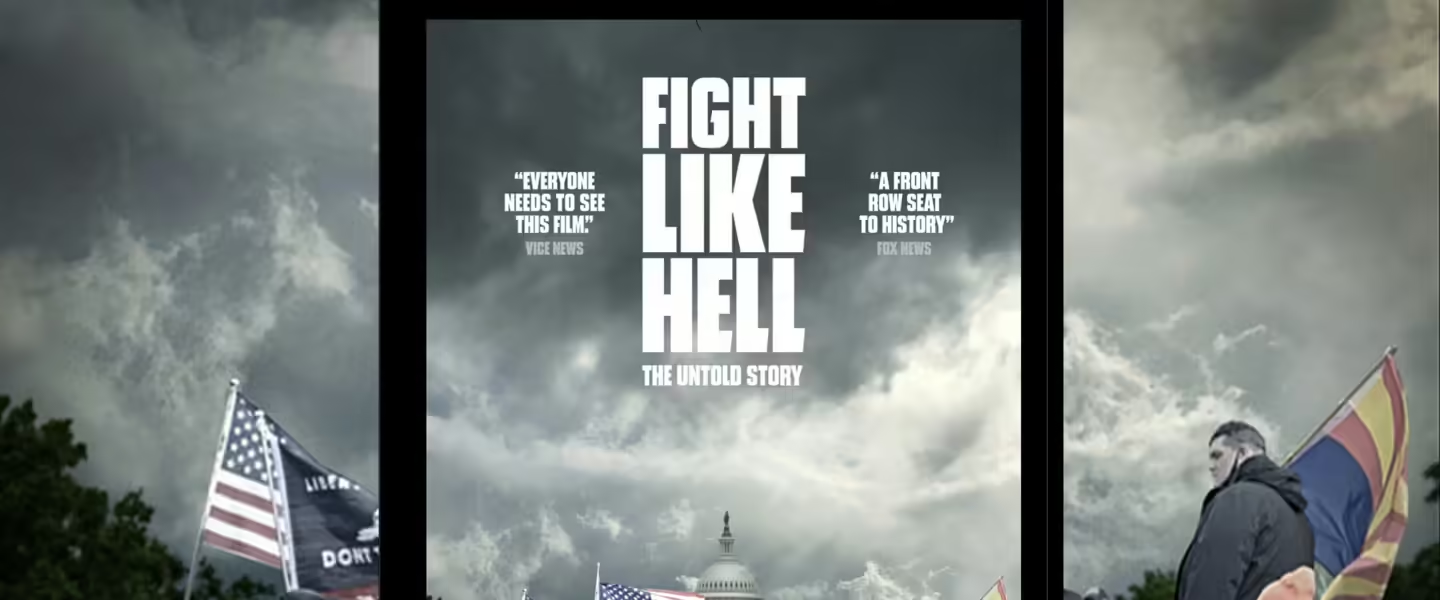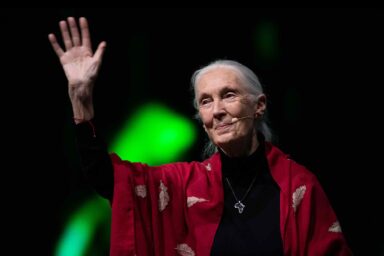Think you know everything about January 6? Think again. Jon Long’s raw, footage reveals shocking truths. Democracy hangs in the balance. Listen. Watch. Decide.
This is January 6 as you’ve never seen it before.
My guest on this week’s WhoWhatWhy podcast is filmmaker Jon Long. Long has just completed Fight Like Hell, a documentary that offers a provocative, unfiltered, never before seen look at the day’s shocking events, and the Stop the Steal movement’s evolution.
Long explains that what you will witness in this documentary may shock you, move you. You may have thought the talk of January 6 was old news, that the candidates and the country had moved on, but not so fast. What happened matters a lot.
As the current election cycle reaches its endgame, the implications of that day risk being overshadowed by other issues. Yet its importance cannot be overstated. It stands as a singular event that challenges our fundamental democratic principles.
In his documentary, Long compels us to reconsider how we interpret political narratives. To gain deeper insight, listen to my conversation with Long and then watch this important documentary.
 Apple Podcasts
Apple Podcasts Google Podcasts
Google Podcasts RSS
RSS
Full Text Transcript:
(As a service to our readers, we provide transcripts with our podcasts. We try to ensure that these transcripts do not include errors. However, due to a constraint of resources, we are not always able to proofread them as closely as we would like and hope that you will excuse any errors that slipped through.)
Jeff Schechtman: Welcome to this special edition WhoWhatWhy Podcast. I’m your host, Jeff Schechtman. In a new legal filing just this week, Jack Smith argues that Trump is indeed responsible for the events of January 6th. In the annals of American democracy, January 6th, 2021, stands as a stark inflection point. A day when the peaceful transfer of power, long considered sacrosanct in America, hung in the balance. Yet, as with many watershed moments in history, the true narrative lies not in the event itself, but in the complex tapestry of actions and ideologies that preceded it.
Today, I’m joined by filmmaker Jon Long, whose new documentary Fight Like Hell offers a provocative, unadulterated look at the genesis and evolution of the Stop the Steal movement. Long’s approach is notable not for what it includes, but for what it omits, the usual chorus of pundits and experts that usually shape our understanding of political events. In an era where media narratives can calcify into rigid orthodoxies, Long’s observational style raises intriguing questions about objectivity, truth, and the role of the documentarian in capturing history.
As we navigate the treacherous waters of another election cycle, with democracy itself on the ballot, Long’s work invites us to reconsider how we consume and interpret political narratives. Jon Long’s film Fight Like Hell documents a movement without becoming part of it and reveals much about the state of American democracy. Jon Long is an accomplished producer, director, and writer who has created films and television programs for major studios and networks.
His work includes the IMAX film Extreme and Universal’s The Search for Freedom. In making Fight Like Hell, Long spent over four years investigating the events leading up to and including January 6th. And it is my pleasure to welcome Jon Long here to the program. Jon, thanks so much for joining us here on WhoWhatWhy Podcast.
Jon Long: Thank you so much for having me.
Jeff Schechtman: Well, it is a delight to have you here. First of all, tell us when you began working on this project.
Jon Long: It was a long evolution. I was fascinated by what was happening in US culture and politics leading up to the 2016 election, like so many others were around the world. I’m from Canada. So I really became fixated on it and was just watching very closely. I didn’t start to actually try to develop a film until COVID started and I started writing treatments around how the Trump administration might handle the COVID crisis. And I was trying to pitch that but it didn’t go anywhere.
I was just continually following and writing different treatments, and then with the George Floyd and the Black Lives Matter, things started to get really crazy and I started to see what was happening down there. And from a journalistic point of view, I just wanted to be in those places to capture such an intense cultural moment without really knowing the direction of what I would do with it.
And I had originally planned to film in DC on Election Day, November 3rd, and then again on the first MAGA March in November, and then the second Million MAGA March in December, but I didn’t make any of those because I was busy working on other projects at the time. And because I didn’t really have a project in the works, I didn’t go. Then when Trump sent out his “Will Be Wild” tweet, I just dropped everything.
I believe it was on December 19th so I wasn’t so busy with my other work and mobilized crews to go down to DC to film the Will Be Wild events that were about to happen. I couldn’t go myself because, being in Canada, the COVID restrictions were so intense at the time. I would’ve had to stay in a hotel for a few weeks. So I worked with some very accomplished directors of photography that I’ve worked with on past projects and got them to DC and the rest is history.
We ended up filming for four days around January 6th, talked to lots of people; then we went back a couple of weeks later and filmed during the inauguration, which was equally haunting in the respect that there’s no one on the streets and there’s barbed wire and it looked like a military nation. So we started working on the film about a year later — because we didn’t really know what to do with this footage — and started putting together a compilation. It was several hours long.
And also started to collaborate with a few other journalists who were actually documenting the Stop the Steal movement when it first started happening in early November, basically the day after the election. And started collaborating with them to tell the story, what was happening on the ground, and all of the planning and rhetoric that led to January 6th. And eventually decided— with these hundreds of hours of footage that we had and all of our own original footage, which was shot with cinema-grade cameras, and I believe it’s the most beautiful footage, if you want to call it that, of January 6th, because most people were filming with iPhones and stuff like that.
And we decided, let’s make a 90-minute movie because that way we can really tell a story, give context, and approach it in a way that will show people rather than tell people what happened. So that’s what we decided to do.
Jeff Schechtman: Much of the footage that was shot on January 6th, both iPhone footage and some of the network and television footage, has subsequently been subpoenaed. Talk a little bit about your footage and whether or not it was, and did it provide any additional information to law enforcement?
Jon Long: Yes. So, as we were starting to create the film, we met someone who was working with the January 6th Committee. She was just a researcher and she said they would probably like to see our footage because no one had seen it at that point in time. And I said I would be totally open to showing it. But we don’t want to just contact them and say, “Here’s our footage,” but if someone were to contact us, we would be open to that. So, she actually arranged a conversation with [Rep.] Jamie Raskin, and this is while they were actually doing the hearings.
And I spoke to him briefly and they sent me a request letter to view the footage. So, I did send the committee all of my footage, so it’s in their hands. What they pulled from it, I don’t know, because they had so much footage at the time, and this was another huge drop of footage. So, I’m not sure that it actually made it into their hearings, but they did receive the footage.
Jeff Schechtman: Talk a little bit about the decisions that you made in terms of the style of this film and how you would construct it. Once you made the decision to do a 90-minute film, was there a specific set of directions, a specific style that you wanted to accomplish?
Jon Long: Exactly, yes. Once we decided on making it a 90-minute film rather than multiple series or whatever, we wanted to do it in an observational way. So, we did not want to go out and do interviews with pundits and experts. Because the footage we have is so observational, our mutual friend Andy Gillies, who used to be head of film at IMAX, it really falls into that IMAX style of filmmaking where you want to put people in a place that they would otherwise not be able to go and do it in an immersive and visceral way.
So, we wanted to do that. There is a narrative that starts on Election Day and goes all the way through to January 7th, but it’s not coming from a narrator or from after-the-fact interviews. It’s all with people in the moment on the ground. So there’s a very cohesive narrative that tells a story beginning, middle, and end, there’s a transformation that happens, everything you would have in storytelling.
It’s actually a much harder way to put a documentary film together than writing narration because it’s so easy to solve a problem by just writing a sentence. So, if we needed a certain sentence, we might have to scour through speeches or media that was happening at that moment in time and construct this story in a way that really flows from beginning, middle to end, but without interviews.
Jeff Schechtman: And talk about Ali Alexander, who was really a principal character in this film and one of the leaders of the January 6th Stop the Steal movement.
Jon Long: Yes, Ali Alexander was a political operative, a Republican operative. He’d been doing that for several years. I think it was 14 years or something at the time when he was organizing Stop the Steal. He was friends with Roger Stone. Stone originally coined the phrase Stop the Steal in 2016, in preparation if they lost the election to Hillary, and then it went away. And then in the next election, Stone in a sense passed the torch to Alexander, who became the lead organizer for Stop the Steal in 2024.
So, he basically was organizing stuff, and doing daily livestream videos on Twitter through an app called Periscope and really just mobilizing Trump followers. And also there’s a lot of other characters who come into the film that are connected with Ali. So you see the connections between Ali and Stone when Ali says that was his friend. Ali is with Alex Jones and Nick Fuentes. And then you hear different dots being connected in terms of Ali saying that he was working with Trump’s legal team, getting them information for their affidavits and things like that.
So all of this stuff unfolds in the film, and you’re really able to see the characters that were at the lead of helping to mobilize and create awareness. Because Donald Trump, who was at the top of the pyramid, was saying before the election that “If we lose, it’s because it’s rigged.” And then after the election that it was rigged.
Jeff Schechtman: What is it about this story as it came together, as the puzzle pieces all started to fit in place? What surprised you about the direction that it took?
Jon Long: The main thing is that so many people were caught up in that. Caught up in that assertion that the election was stolen. Which, I can see them following that. But once the evidence was coming out in terms of there was over 60 court cases that got thrown out, after all of this stuff was refuted and no one brought credible evidence, although they continued to talk and they still do talk about evidence, I was surprised at how many people still held onto the belief that the election was stolen.
So that was surprising that so many people are still toeing the line that the election was stolen.
Jeff Schechtman: Talk about January 6th itself and how the footage shows the way events happened, the way events unfolded; who, if anybody, was in charge; and what it told us about the planning and what came before.
Jon Long: Well, I think really what it shows is January 6th was not a spontaneous event that just happened or just erupted on the day. There was a lot of planning leading up to it, and that’s what the film shows. The first 25 minutes of the film is the time period from November 2nd to January 5th. And it just shows the people, what they’re seeing, the planning, the rhetoric. And you can feel that there’s a lot going on there such that it feels like it could become very contentious.
And even on January 5th, the night before, there was a standoff between Trump supporters and the police officers at BLM Plaza in Washington, where they were screaming at the police officers saying “Heads are going to roll, you can’t stop what’s coming tomorrow,” and that type of thing. So a lot of this felt like it was almost inevitable. But again, it’s like there’s so many people there. That was a small group of people, I guess late at night on January 5th, and they estimate that it was over 100,000 people that attended the event on January 6th.
And a couple of thousand people are estimated to have broken into the Capitol. So two things can be true at the same time. There could be a lot of people there who are there for a peaceful protest, and there are other people there who are smashing cops over the head with poles. So I think a lot of the problem comes in the media, on either side of the media, when they take stuff out of context.
If it shows someone peacefully walking through the Capitol with a police officer beside them, and they talk about that as a story. And then someone else talks about the story where there’s this body-cam footage of a police officer getting the hell beat out of them. Rather than putting it all in context and saying two things can be true at the same time. Peaceful protests are great; that’s called democracy. But attacking police officers and smashing into the Capitol building is not great.
Jeff Schechtman: How much of it was planned? How much of the violence was intended, and how much of it happens spontaneously do you think, after viewing all of this footage?
Jon Long: Again, it’s different for everyone. I’m sure some people had no intention of smashing in or even going into the Capitol, and they got caught up in the moment. There were other people who were probably there and they wanted to be violent. They knew what they wanted — to break in. And there was a lot of people who just went there to have a peaceful protest. So I don’t think that it was absolutely a spontaneous thing.
I think for some people this was planned. And there are parts in the film where you see people actually talk about going right into the Capitol. And so I think, again it’s a diverse group of people with different intentions.
Jeff Schechtman: And talk a little bit about how you have gotten the film out there into the public and made it available to people to see.
Jon Long: So we were working on this for a few years. It was definitely a struggle to get this made as an independent filmmaker. Distributors and platforms for the most part, were not interested in being involved, either because they were either doing their own films or they just did not want to touch something that was such a [laughs] political hot potato. And so we just cobbled it together on our own and we got it done a few months ago. And we thought the best thing to do in terms of getting it out there—
And there were different options, like you can put it out on iTunes or you can put it on YouTube or whatever. We decided we wanted to put it out on YouTube, at least until the election and probably the inauguration, so that people can see it because it’s a social impact film. And we basically want it to inform the electorate about what happened so that they can see what happened without someone telling them what happened and that can inform their decisions coming into the next election.
Jeff Schechtman: Now that you have seen this story in its totality, to what extent was the reality of what happened as depicted in the film, to what extent was that different from or the same as what the media narrative was in the immediate aftermath?
Jon Long: Well, the immediate press narrative was, again, like so much that we hear in the press now, everything is so monolithic. So everyone there is an insurrectionist. So that is going to turn off a lot of the people who were there who were peaceful protestors. And yet still there were people there who were hammering on cops. So I think that that’s the biggest problem is they don’t explain as well as they should that there are different things happening at the same time there.
Jeff Schechtman: And talk about the impact that this film has had on you and as a Canadian in particular, how you view the state of America today.
Jon Long: Well, I think as a Canadian or people around the world, they’re watching because this is such a critical election. And to see those images on January 6th was just so astonishing for everyone in the world. So I think everybody’s really watching to see what’s happening, and there’s so much rhetoric right now and it seems to be getting more and more violent, the rhetoric. And there’s also the planning of the Stop the Steal that could happen again.
If Kamala were to win, then it’s going to be contested. And either way, I think there’s going to be a lot of tension. So we’re all watching and just hoping that— from a filmmaker’s point of view, I just hope that people come away with [an understanding] that political violence is not acceptable. Protest is great. People need to disagree because that is the essence of democracy — people with completely different perspectives but being able to communicate respectfully with each other.
And that transformation actually felt like it happened on January 6th. So the evening of January 6th, after Trump told people to go home, you had these leaders in the Republican Party like Mitch McConnell and Lindsey Graham, and then people on the media like Sean Spicer and also Kevin McCarthy, saying, “This is un-American. This is totally unacceptable. We have to have a peaceful transfer of power.
And then within a week or two, it was back to, “No, we’re back on board. We think it was stolen.”
So I’m just hoping that people can see this film as a precursor to what could happen again and help them understand the various things that were at play the last time around to better inform them about what’s about to happen.
Jeff Schechtman: And finally Jon, enough people have seen the film at this point to engender enough reaction to begin to measure and ascertain what that is. Talk about what the reaction to the film has been so far.
Jon Long: So it’s on YouTube and anyone can go watch it for free. And there’s thousands, I think there’s almost 5,000 comments. So you can just start reading through the comments. But generally speaking, the thing that comes up the most is that everyone is saying, or people are saying everyone needs to see this film — we can’t let this happen again. And that’s pretty much overall what the comments are reflecting and what a horrible day it was.
But the comments are very encouraging, very supportive in terms that people really appreciate that the film got made, how it was made in a way that is observational so that really any audiences can watch it. It’s coming from an independent point of view. It’s not coming from a right or a left. We’re not having right-wing commentators or left-wing politicians to help tell you the story. Pretty much the whole film is Trump supporters, beginning to end.
It’s like an IMAX film in that sense. It’s like you’re there. It’s a visceral, immersive experience and you can just see what’s happening.
Jeff Schechtman: Jon Long, the film is Fight Like Hell, available, as Jon says, on YouTube. Jon, I thank you so much for spending time with us here on the WhoWhatWhy podcast.
Jon Long: Thank you so much.
Jeff Schechtman: Thank you. And thank you for listening and joining us here on the WhoWhatWhy podcast. I hope you join us next week for another WhoWhatWhy podcast, I’m Jeff Schechtman. If you like this podcast, please feel free to share and help others find it by rating and reviewing it on iTunes. You can also support this podcast and all the work we do by going to whowhatwhy.org/donate.



